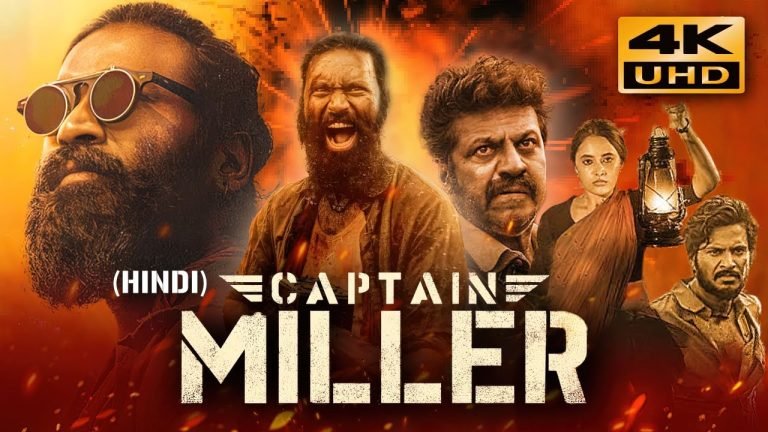Title: Captain Miller
Director: Arun Matheswaran
Lead: Dhanush as Analeesan aka “Miller”
Language: Tamil (dubbed in Telugu, Malayalam, Kannada), runtime ~157 min
Setting: 1930s British Raj, rural Tamil Nadu

[table id=5 /]
🎯 Premise & Central Conflict
Miller begins as a low‑caste villager oppressed by his own feudal lord and caste elites. Seeking dignity, he enlists in the British army but ends up fighting his own conscience when coerced to suppress his fellow villagers. As guilt overtakes him, he leaves the army and reinvents himself as Captain Miller, a vigilante determined to liberate his people from both colonial and caste-based oppression .
🧍 Protagonist Profile – Analeesan / Miller
-
Caste‑oppressed villager whose initial motivation is respect and survival
-
Transforms through guilt and injustice to a rebel leading armed resistance
-
Embodies dual rebellion: against colonial rule and entrenched caste structure
Dhanush delivers a layered portrayal quiet intensity, internal turmoil, explosive transformation—the kind that earned him widespread acclaim.
🤝 Supporting Characters
-
Kannaiya, played by Elango Kumaravel: tribal mentor figure, akin to Schultz in Django Unchained.
-
Sengolan (Shiva Rajkumar): Miller’s brother, whose death triggers key turning points for Miller.
-
Priyanka Mohan, Sundeep Kishan, Aditi Balan: Miller’s comrades in arms each revealing caste and gender politics in a tumultuous era.
🧩 Narrative Structure & Themes
-
The film unfolds in six chapters, non‑linearly, with time jumps and backstory reveals
-
Core themes:
• Caste oppression vs colonialism showing caste as a more insidious force than imperial rule.
• Identity & honor Miller grapples with self‑worth and moral responsibility.
• Freedom and violence raising uncomfortable questions about the cost of liberation.
Reviews compare it to a Tamil Django Unchained, but with thoroughly original cultural textures.
🎥 Cinematic Style & Audio Landscape
-
Visuals: Cinematographer Siddhartha Nuni uses stark rural landscapes, shaky camera work in battle scenes, wide majestic frames to emphasize hierarchy and upheaval.
-
Editing: Firm pacing, tight chapter transitions; builds tension and character depth progressively.
-
Music & sound design: GV Prakash Kumar blends percussive intensity in battle with subdued melodic underscores in emotional moments. Drum-heavy arrangements give battle scenes resonance, quieter passages underscore Miller’s introspectio.
🔍 Critical Reception
-
Indian Express gave 4/5 stars, applauding it as a political drama disguised as an actioner, powered by Dhanush and smart analogies to global struggles.
-
India Today similarly praised Dhanush’s performance and the layered narrative.
-
The Hindu noted some pacing issues in the first half, but lauded the film’s chapter structure and thematic weight.
-
Film Companion offered a warning: visually striking and thematically bold, but perhaps too gory for some tastes.
⚠️ Controversy Note
A writer claimed the film lifted ideas from his novel Pattathu Yaanai, he intends to challenge the creators, but the filmmakers deny any connection.
Storytelling Of Captain Miller
The story begins in the 1930s, in a dusty, caste-divided village in South India, during British colonial rule. A boy named Analeesan, born into a so-called “lower caste,” lives a life of humiliation. He is mocked, pushed aside, and never allowed to enter the temple or even walk with dignity on the same path as upper-caste landlords.
From a young age, he dreams not of revenge, but of respect. He sees the British soldiers march through the village and thinks maybe if he becomes one of them, wears that uniform, he’ll be treated like a man.
Becoming the Enemy: From Analeesan to Soldier
In his early adulthood, Analeesan runs away and joins the British Indian Army. They give him a name “Miller” stripping him of his past and heritage. For a while, Miller believes he’s made it. He’s wearing boots. He’s saluting. People fear him.
But the illusion breaks when he’s ordered to carry out a brutal operation a massacre in his own land, against villagers protesting unfair taxes. He watches his people die at the hands of soldiers he once admired. He’s ordered to open fire on innocent people. And he does.
That moment breaks him. He realizes he is no hero just a pawn for colonial oppression. The guilt doesn’t just haunt him. It devours him.
Transformation: The Rise of Captain Miller
Miller deserts the army. He vanishes into the forests, where he is taken in by a group of tribal rebels. There, he meets Kannaiya, an older revolutionary who teaches him how to fight not with blind rage, but with purpose.
Miller slowly transforms from a soldier into a freedom fighter. Not a Gandhian but a guerilla. His war is not symbolic; it’s literal, bloody, and personal.
He returns to his village not as Analeesan, not as Miller the soldier, but as Captain Miller, a masked rebel. He begins attacking British convoys, stealing guns, redistributing wealth, and burning down the bungalows of zamindars who exploit the poor.
Family and Tragedy
Miller’s revolution starts drawing followers. Among them are Sengolan, his elder brother, a pious man who believes in dignity without violence. Sengolan disapproves of Miller’s path.
But when the British learn who Captain Miller really is, they retaliate. They arrest and execute Sengolan in public framing him as the rebel. His death becomes the moment that drives Miller beyond redemption.
Miller now fights not for hope but for vengeance.
The Heist and the Turning Point
In the second half of the film, Miller plans a daring raid on a British military treasury, hidden inside a fortress-like compound. The mission is high-risk and the centerpiece of the film’s action.
With a team of loyal rebels, including a brave woman named Velmathi and a former sepoy named Rafiq, Miller breaks into the fort in broad daylight. Explosives. Horses. Crossfire. Cannon smoke. It is cinematic chaos.
They succeed barely. But half his team dies. The loot is distributed to starving villages. The people begin to see him as more than a rebel they call him a god.
The Final Confrontation
The British declare Miller a terrorist. A new British officer arrives, ruthless and clever. He sets a trap using the village temple as bait threatening to demolish it to draw Miller out.
Miller arrives not to fight, but to speak. He gives an impassioned monologue, rejecting both the British empire and the caste system. He reveals that the real enemy is not just the colonizer but the Indian who oppresses his own people in the name of purity and class.
But the British fire. A massive battle ensues. Miller fights like a man who has nothing left to lose. Wounded, outnumbered, and cornered, he finally dies not captured, not defeated, but a legend.
His body disappears into the flames. But the myth remains.
Ending: The Beginning of a Legacy
The film ends with children playing in the same village streets. One of them runs past a wall where someone has scribbled a line in charcoal:
“Captain Miller still lives.”
The message is clear. Miller the man is dead. But Miller the idea of rebellion, of dignity, of resistance has just begun.
🏁 Final Word
Captain Miller is a compelling hybrid of mass‑market action and socially conscious drama. Its emotional power lies in Miller’s rise, not just as a soldier, but as a rebel challenging multiple systems of oppression. Dhanush’s deeply committed performance and Arun Matheswaran’s audacious storytelling combine to create a film that entertains, provokes, and lingers long after the screen goes dark.

